Bryoandersonia
Bryologist 65: 137, figs. 192 – 205. 1963.
| Taxon | Illustrator ⠉ | |
|---|---|---|
 | Bryoandersonia illecebra | Patricia M. Eckel |
Plants large, in dense or moderately dense tufts, green to golden brownish. Stems creeping or more commonly ascending to erect when in dense tufts, julaceous, irregularly pinnate, branches terete-foliate; central strand present; pseudoparaphyllia acute; axillary hairs of 4–6 cells. Stem-leaves erect-spreading, loosely imbricate in older parts of shoots, closely imbricate at shoot apices (or dense throughout shoots in compact tufts), broadly ovate-triangular to broadly ovate, strongly concave, slightly plicate; base narrowly short-decurrent, somewhat auriculate; margins serrate to serrulate; apex gradually tapered, short-acuminate or apiculate; costa to 50–90% leaf length, narrow, terminal spine absent; alar cells subquadrate to short-rectangular, broader than basal-cells, walls thick; laminal cells linear, slightly flexuose, walls moderately thick; basal-cells broader than more distal cells. Branch leaves similar. Sexual condition dioicous; perichaetial leaves reflexed, apex acuminate. Seta red to redbrown, smooth. Capsule inclined to horizontal, brown, oblong, slightly curved; annulus separating by fragments; operculum broadly long-rostrate; peristome xerocastique, perfect. Calyptra naked. Spores 13–17 µm.
Discussion
Species 1.
Bryoandersonia was segregated by Robinson from the heterogeneous Cirriphyllum, where it was placed by A. J. Grout (1898). Phylogenetic analysis by M. S. Ignatov and S. Huttunen (2002) confirmed the independent status of this genus, which is probably one of the most isolated and ancient in the family.
Selected References
None.
Lower Taxa
"long" is not a number."broad" is not a number.